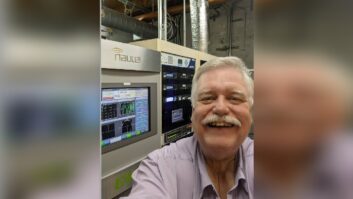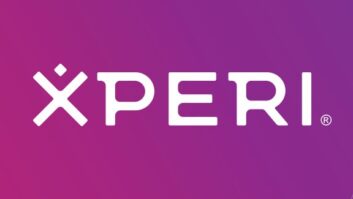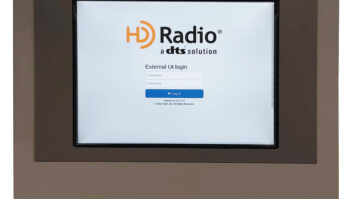Like a proud admiral smashing champagne over the bow of a sleek new battleship, Ibiquity President and CEO Bob Struble launched HD Radio on its maiden voyage into uncharted digital waters at January’s CES Show in Las Vegas.
Ibiquity announced that approximately 100 stations representing most of the major groups across 26 markets will be broadcasting in HD within the next few months. By the end of the year, Struble estimates that more than 300 stations will be HD.
Playing to a tough crowd
Eight manufacturers showed HD Radios, including seven with in-dash models. They played with scrolling song title and artist info along with other data. Ho-hum for most of the crowd who were looking for high tech, gee-whiz stuff. That was to be expected.
It’s not easy for any new technology to get noticed at this mammoth event, especially a tired 80-year-old service like radio. TiVo, MP3 boxes and lots of wireless gadgets grabbed most of the attention, while some attendees thought HD Radio got swept aside as irrelevant at this show.
Unfortunately they completely missed the point. The CES brass understood what HD means for the revitalization of the grand old medium and presented HD Radio with the CES “Best of Show” award. Many radio engineers who talked to Radio World onsite said they were impressed with the HD-R showing.
Gentlemen, start your HD engines
What is emerging as the HD rollout leaves the gate is simply this: The future of everything electronic is digital. Radio now has a workable, flexible pathway into an all-digital world using Ibiquity’s technology that most of the industry now supports. Deployment of this kind of technical upgrade will always start in the larger markets by companies that know the value of seizing any competitive advantage early and are willing to pay for it. The race has just begun.
HD Radio naysayers will continue to whine about “no killer app,” degraded audio and artifacts and HD-R causing interference to adjacent channel analog stations. Nobody ever promised a perfect solution. The real world always throws curveball surprises at the best of human inventions. There will be bugs to flush out and performance issues that need fine tuning in any new technology that brings radical change.
What we need to do is step back and embrace HD-R as a process and just be patient. Realize it’s an evolutionary technology that continuously offers backwards-compatible improvements as new features, better algorithms and better codecs emerge and become integrated into the chip sets of both transmitters and receivers.
Thank God digital can do that so much better. The analog radio turnip has been squeezed dry in this regard and really has nothing more to offer in the way of meaningful new feature sets or better performance.
In search of the killer app
A single killer app may seem elusive at the beginning stages of this rollout, but for a medium that still must deliver information and entertainment as its core product via a listening experience, HD Radio may not need one. It’s not hard to see how the collective list of improvements and new features that HD will bring to the dial form a compelling story for prospective buyers of new radios.
Beyond the basics of eliminating multipath and noise interference, plus expanded data and scrolling text info, there’s a whole new universe of interactive opportunities that HD-R will offer. Mobile commerce enabled by the “buy button” promises to open up a new market place. Audio on demand or “radio TiVo” will allow listeners to replay any program previously aired when they want it. Both features should appear in future HD-R receivers.
If those won’t do it, there are at least two future offerings that have not yet been widely reported which could emerge as the killer app for HD-R.
The first is the “surround sound” listening experience that’s been selling like hotcakes over the past year in home theatre entertainment systems.
Surround sound on HD Radio is the brainchild of a company called Neural Audio Laboratories in Seattle. Neural is a software firm focused on digital audio enhancement with specialized production and processing tools. XM Satellite is using its processing software to reduce annoying codec artifacts.
Extrapolating the home theatre multi-channel 5.1 sound engine into radio, Neural taps into the HD-R bitstream for integration of their stereo surround transcoder (SST) algorithm, using a center-channel fifth speaker. That’s easy for a home entertainment center but will need the cooperation of the big automakers to add this to car radios.
Most car sound systems already use four speakers. One more will bring the awesome power of true surround sound to HD car radio listening. The neat thing about this version of surround sound is you can be sitting anywhere within the five-speaker field to experience the multi-dimensional impact and depth.
Turning on Tomorrow Radio
The other breakthrough possibility for HD Radio has just been announced after heavy lobbying by NPR over the past several years: the possible addition of a second digital audio channel and programming service on the IBOC HD carrier.
This is a feature that various groups have thought should be part of any new digital delivery system from the beginning of IBOC development. It’s technically possible, but Ibiquity has never recommended doing it as it means giving up the blend to analog and instant-acquisition tuning features. The results of the tests hopefully will show the second channel is viable.
NPR has led the fight on behalf of its many member stations that want both a music service and a news or public affairs talk service on one FM HD-R station. They’ve teamed up with Kenwood and Harris to test the second digital channel concept with a multi-year, multi-million dollar project called Tomorrow Radio.
The major question the involved companies hope their tests will answer is whether splitting a station’s spectrum into two channels would still allow those streams to be robust enough to serve receivers that are moving – the “mobile environment.”
Kenwood USA will do the initial testing on KKJZ(FM) in Long Beach, Calif., later this year. Harris Broadcast will provide the RF gear. If it works well, HD Radio rises to a new level.
Dealing with HD interference
I’ve covered the thorny issue of digital hash that can interfere with adjacent channel analog listening in previous columns. While it’s mostly a non-issue for FM, HD Radio on AM may be an uphill battle, at least for a while.
As more folks listen to the WOR 710 HD-R transmissions in the Northeast, it’s becoming clear that wider bandwidth radios are causing trouble.
Ibiquity continues to test receivers both in the lab and in the field and is adding to the growing list of the offenders. Let’s hope the list doesn’t get too long. If this becomes a big problem rolling out HD-R on AM, the FCC can always take my suggestion and have AM stations wait for maybe 5 or 10 years and require all stations switch to all digital at the same time. But it’s probably more likely they will authorize HD-R on AM one station at a time, carefully considering its potential to create significant interference.
How the FCC will handle interference complaints from listeners is not yet clear, but we do know they can require any station authorized for HD-R transmission to reduce its digital power levels if such complaints are real and widespread, or in extreme cases, to turn off the digital entirely. I’m guessing most will come from radio engineers and AM DXers.
Several such individuals have recently filed formal requests with the commission pleading for more comprehensive testing before HD rules are adopted formally. Some of the hard-core HD opponents will be tempted to stack the deck, so the commission will need to be careful here.
AM stereo inventor Leonard Kahn, we hear, has petitioned the FCC to reconsider its decision to authorize HD Radio. Not surprising considering Leonard’s history.
These petitions are sure to slow the adoption process down even more.
The bottom line is that no stations or classes of listeners are going to be afforded protection because of receiver deficiencies. The FCC should make its determinations on interference based on protected signal level contours. Ibiquity thinks the vast majority of AM complaints about HD noise will come from fringe area listening that is not generally afforded protection under the present rules.
The real costs
It’s clear that most major groups plus many smaller owners are sold on the prospects for HD Radio and have completed negotiations with Ibiquity for HD implementation in not only the targeted rollout markets, but in many smaller markets as well. Greater Media is committed to add HD to all 19 of its stations right away.
In the grand scheme of figuring the cost vs. reward risks of adding HD, the larger market stations and groups are seeing it basically as a no-brainer.
Early conversion estimates pegged the typical per station price tag between $100k and $200k. That range is roughly what a given larger market station would spend every year in total capital improvements and upgrades. It’s also the typical gross monthly billing for a top 4 station in markets 150 to 250. Decent top 25 market stations make that much in a week.
If you want your station to be part of the next generation of the American radio experience, adding HD-R is not hard to justify, especially with the industry averaging about 20 percent return on investment. The big question is when should the commitment be made and the money spent?
The answer to that, of course, is largely based on whether your station is privately or publicly owned, and when upper management and the bean counters will make available the funding for such a capital project.
With the economy and the markets still sputtering, many companies understandably are making such commitments slower than they normally would. One positive bit of recent news that should bring this price down for many stations on master antennas is the ability to use a separate low-power digital transmitter for HD Radio feeding the existing combiner’s wide-band port “backwards.” Such a configuration would use a separate feedline into the center bays of the existing master panel antenna via modified hybrid antenna element combiners. Eventually the FCC may authorize a nearby separate antenna for such use. You’ll be seeing more on this revelation soon.
The most important factor that will push HD-R adoption is how fast new receivers fill the marketplace and whether your main competitor has already added HD-R. It’s safe to assume that process will take at least a year before a significant percentage of consumers even become aware of HD Radio and buy their first set. You can bet that any owner not running HD-R will quickly jump on board when research data and Arbitron diaries start mentioning HD-R and digital radio advantages on competing stations.
Only HD Radios on tomorrow’s shelves
If Bob Struble is right and the majority of radio listeners will be able to hear most of their favorite stations in HD Radio by the end of next year, it’s safe to assume most radio manufacturers will thereafter begin to phase out analog-only designs from the marketplace. They don’t want to support both chip sets any longer than they have to as price margins for HD-R models become competitive. The buying patterns should follow the course already traveled by VHS displacement with DVD.
There are still a number of obstacles ahead for this maiden voyage of HD radio, but it’s hard to fathom what could manage to sink it after such an auspicious launch. Grab your life jackets for what promises to be an exciting adventure.











